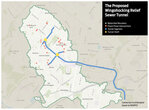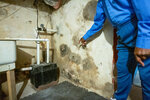The Rev. Chester Williams has been dealing with floods in his basement since 1969. Ever since, chronic flooding and sewer backups have been getting worse.
This item is available in full to subscribers.
We have recently launched a new and improved website. To continue reading, you will need to either log into your subscriber account, or purchase a new subscription.
If you are a digital subscriber with an active subscription, then you already have an account here. Just reset your password if you've not yet logged in to your account on this new site.
If you are a current print subscriber, you can set up a free website account by clicking here.
Otherwise, click here to view your options for subscribing.
Please log in to continue |




The Rev. Chester Williams has been dealing with floods in his basement since the fall of 1969, when he returned from service in Vietnam and bought his house in Germantown. Chronic flooding and sewer backups have been a fact of life for him and many of his neighbors ever since – and it’s getting worse.
The water itself is whimsical, he says. His home on the 6200 block of Chew Avenue can flood whether rains are heavy or light, and can reach as high as the basement ceiling. But the crumbling plaster, damp air and constant odor of mildew it leaves behind are all too predictable.
“I always tell people not to leave anything in their basement, or if they do, to make sure it’s in a waterproof container,” he says. “I know too many people who’ve lost so much – expensive equipment, yes, but also family photos and mementos that you can’t replace.”
Over in East Mt. Airy, East Mt. Airy Neighbors president Linda Bell hears many similar complaints. And while she lives on higher ground, and not in the chronic flood zone, she knows firsthand what it can be like. When her own sewage line backed up into her basement last January, the bill for cleaning up the moldy mess came to a whopping $23,363.67. Insurance eventually covered about 80% of the cost. “But then my premium went way up – by $531.40.”
It’s a hidden tax that comes with the territory for many residents in these neighborhoods, where insufficient capacity in the sewer line means certain flooding – and basement backups – during heavy rains.
The Philadelphia Water Department is well aware of the problem. The utility is now halfway through its award-winning “Green City, Clean Waters” plan, which aims to tackle sewer problems across the city primarily by absorbing stormwater with green infrastructure such as trees, gardens and rain barrels. In the Northwest, PWD is also considering a major traditional infrastructure project – a massive five-mile tunnel underneath both neighborhoods – to address the acute flooding and basement backups there.
Dubbed the Wingohocking Relief Sewer Tunnel, the potential solution would likely cost up to $800 million and take at least a decade to complete, according to recent PWD estimates. And while the PWD has selected the engineering firm Brown and Caldwell to do a preliminary assessment, it has yet to raise the full $5 million needed to pay even for this small first step. The City did get $103,000 in Federal Emergency Management Agency (FEMA) Building Resilient Infrastructure and Communities (BRIC) funds, but it’s still looking for $3.6 million in federal assistance before it can pay for the work. The proposal is now more than a year behind schedule with no apparent start date on the horizon.
“It does seem to still be more of a theoretical prospect than an actual project,” says Adam Nagel, director of government affairs at PennFuture, a statewide nonprofit focusing on a clean energy economy and protecting air, water, land and sustainable communities.
Meanwhile, people like Bell and her neighbors have no idea what may be coming, or what the city has in mind.
“There’s too much that’s not being talked about,” says Maurice Sampson of Mt. Airy, who serves as Eastern Pennsylvania’s director of Clean Water Action. “I think they don’t tell us because they’re afraid of how we’ll react, but the City’s attitude of not talking, and not sharing information, is not serving us well. We have a really difficult situation on our hands and our elected leaders need to be clear with residents about what’s going on.”
The problem
As currently proposed, the tunnel would address twin problems of chronic flooding in lowland areas of East Mt. Airy and Germantown and sewage overflow into the region’s rivers and creeks.
Both issues stem from decisions made generations ago when City officials encapsulated and paved over Wingohocking Creek, which had been used as a de facto sewer by nearby houses and businesses, turning it into a sewer pipe. Like many cities that grew and developed during those years, they used the same pipe to carry stormwater.
Both neighborhoods continued to grow, adding many more new houses and businesses with each passing year. And now, almost a century later, the line is much too small for the load it has to carry.
While flooding is particularly severe in this part of Northwest Philadelphia, there are strained sewer lines all over the city. Its vast network of overwhelmed former creeks now dump billions of gallons of stormwater mixed with raw sewage into our waterways each year – from Tacony and Cobbs Creeks to the Schuylkill and the Delaware Rivers.
This, of course, violates national standards for clean water. So more than a decade ago, PWD entered into a $2.5 billion agreement with federal regulators to address the problem with the Green City, Clean Waters plan. Most of that spending – $1.7 billion – was slated for building the green infrastructure that would capture stormwater before it could reach overwhelmed sewer lines. It was hailed as a nationally innovative approach during a time when other major cities like Milwaukee and Chicago were spending the bulk of their billions on traditional, gray infrastructure solutions like tunnels.
The Chestnut Hill Local, in partnership with Grid Magazine and Delaware Currents, has previously reported that, with the plan at its halfway mark, some clean water advocates are questioning whether it’s enough. With PWD currently on pace to miss its target for green infrastructure installations by a 2035 deadline, and the City’s sewers still spilling upwards of 10 billion gallons of untreated overflow into our waterways per year, they wonder whether more money should be spent on traditional infrastructure, like the proposed Wingohocking Tunnel.
The historic Wingohocking Creek sewer currently sends more raw sewage into waterways than any other in Philadelphia, and advocates say the decision about what to do is pivotal.
“It’s really crazy that, 50 years after the Clean Water Act, we still have this condition,” says Julie Slavet, executive director of the Tookany/Tacony-Frankford Watershed Partnership Inc., which advocates for the Tacony Creek, the current dumping ground for the Northwest’s extra sewer water. “This is the biggest sewer shed in the city – it’s crazy how big. Just the fact that Germantown stormwater and sewage end up over here in our creek shows you how enormous the problem is.”
The plan
According to water department documents, the proposed tunnel would address flooding in Germantown, where it is the most severe, and also parts of East Mt. Airy, Logan, Feltonville and Juniata Park.
It would be about five miles long with a 10 to 20-foot diameter and run some 50 to 100 feet deep under East Mt. Airy and Germantown, from Chew and Washington Lane to Tacony Creek Park. It would function as a storage tank for combined stormwater and sewage during heavy rains; a second tunnel would carry the wastewater to the Northeast Treatment Plant where it would be treated before being released into the Delaware River.
To drill the path for this proposed tunnel, contractors would need to sink at least two deep shafts, which they would use to position boring equipment for drilling large horizontal holes. From above ground, neighbors would simply see two big construction sites (locations under consideration include Washington Lane between Chew Avenue and Ardleigh Street, and on Church Lane near Chew Avenue).
While the tunnel appears to be the likeliest solution, PWD is also asking engineers to consider a series of large underground storage tanks as an alternate choice. These would be easier and less expensive to build – PWD estimates up to $600 million. But they would be more expensive to maintain and could also stink.
Proposed sites for such tanks are SEPTA’s Sedgwick Regional Rail Station, the Finley Recreation Center, Cliveden Park, Martin Luther King High School, the Lonnie Young Recreation Center and the Waterview Recreation Center.
According to a 2019 PWD report, either option could reduce flood depths by as much as 80% and eliminate up to two-thirds of basement backups.
Green City, Clean Waters
Taking this much sewer overflow off neighborhood streets would result in a major step toward satisfying the City’s obligation to meet federal clean water standards, which PWD has promised to do with its Green City, Clean Waters initiative.
Still, Patrick Starr, the southeast region’s executive vice president of the Pennsylvania Environmental Council, says some environmental advocates are leery of such a big civil engineering project.
“Some people are suspicious of the tunnel because they’re worried it might be an example of the City pulling back from the green infrastructure plan,” says Starr, who describes himself as a “big defender” of the green infrastructure plan. “But I have come to understand that you’ve got to do something significant, and this is exactly the kind of gray infrastructure intervention that makes the most sense. The overflow into the Tacony is such that, frankly, it would be really difficult to address with green stormwater solutions alone. The park itself is nice, but the creek water? I wouldn’t get near it.”
Howard Neukrug, who now leads the University of Pennsylvania’s Water Center and was instrumental in developing Green City, Clean Waters in his former role as PWD Commissioner, says gray water infrastructure like the Germantown tunnel was always supposed to be a major part of it.
“Green City, Clean Waters was always a huge gray infrastructure project, it’s just that the part that gained national attention for being such a progressive vision was the green part of it,” he says. “Both are incredibly important in their own way, and without the two parts we would not have reached agreement with the federal government.”
Neukrug also says that flooding in Germantown – and all over the city for that matter – is a predictable result of mixing Philadelphia’s historic choices with the increasing impact of development and climate change. The creeks and streams that once helped move stormwater are now encased in bricks and cement, and too much of the land that could have absorbed it is covered with impervious surfaces, like buildings and parking lots.
“The reality is that the land here was doing very well before we got involved, and now we built these houses next to sewers that have rivers running through them.”
In the meantime
Whatever fix the City chooses, it’s likely to be years away. Meanwhile, the rains keep coming, bringing a slow-rolling wave of destruction with them. Not only does chronic flooding damage residents’ property, it gnaws away at the ground beneath their feet. Pooling water can weaken old brick sewers until they crack and let soil wash in, causing streets to sink.
“I’ve been at meetings where people talked about how the [utility] pole in front of their houses was leaning because there wasn’t any dirt left under the sidewalks,” Slavet says.
Bell points to the sinkholes that often open up along Musgrave Street. “We have massive erosion there, from Hortter Street all the way to Chew Avenue. It caves in periodically and then gets patched up, yet we still have the City handing out new building permits. There’s a new set of nine townhouses planned for right around the corner on Pleasant Street. What kind of impact do you think that’s going to have?”
Residents are wondering why there isn’t a better plan for the here and now.
In early 2020, PWD did convene the Germantown Community Flood Risk Task Management Task Force to discuss problems and solutions. As a result of those meetings, the department conducted a neighborhood survey about prior flood experiences and climate change, put up some road signs that warn of potential flooding, published a fact sheet and mailed informational brochures about flood risk and flood insurance to thousands of neighbors on flood-prone blocks.
It also collaborated with the U.S. Water Alliance to fund an arts project, led by Philadelphia’s then-Poet Laureate Trapeta Mayson, to help build awareness. In her report on that project, Mayson noted just how difficult that is in Germantown, where a mix of chronic social ills can feel more pressing than occasional floods.
“Sparking conversation around a specific issue that only comes up for people at certain times (like when there is a historic rain event) when there are so many other immediate issues impacting them on a daily basis – gun violence, gentrification, food security, and jobs – can be difficult,” she wrote in her report on the project, Healing and Repair from a History of Flooding in Philadelphia, Pennsylvania.
Other solutions
While awareness is good and debate over what mix of green or traditional infrastructure is needed to solve the Northwest’s flooding problems is paramount, Sampson says he thinks the City should be taking much more aggressive steps to help. Mandatory disclosure of flood risk during real estate transactions, for instance, would be a good start.
“People need to know what’s going to happen so that they can make some decision about where they’re going to live,” he says. “Would that result in a great outpouring of anger? Yes. And it may not be practical. But it certainly is rational.”
Williams agrees.
“It’s just not right that we weren’t told what the situation is when we bought these houses,” he says.
According to PWD spokesman Brian Rademaekers, the Water Department does not have the authority to regulate disclosure requirements during real estate transactions.
Federally recognized floodplains, which usually follow open waterways and are outlined by FEMA, come with strict federal oversight of what can and cannot be built. But Germantown’s floods don’t show up on FEMA maps because the creek was covered up long ago.
Rademaekers suggested that homebuyers check online sites that track actual flooding events, such as riskfactor.com and crexi.com.
“RiskFactor.com serves as the current best home buyer alert for potential flood risk in Germantown, and it is now included in nearly all real estate transaction databases on which properties are publicly listed for sale,” he says. “We've found them to be quite accurate for the entire upper Northwest section of Philadelphia, including Germantown.”
Williams says he thinks it's unfair that residents like him weren’t told about the flood risk before buying – and that the City should help residents pay for cleaning up the mess. “The City knew this was a problem, and never told us that we were in a flood zone.”
Emaleigh Doley, executive director of the Germantown United Community Development Corporation, says government help with the cost of insurance might be the most pressing need.
“Some government entity is needed to broker insurance because it’s so hard for people to get coverage,” Doley says.
Slavet points out that small-scale solutions shouldn’t be overlooked. “Sometimes it seems like we look at really big solutions, instead of just going property by property and considering the best option,” she says. “There are places in our upstream communities where houses flood regularly, and eventually the township bought out the owners and demolished the buildings.”
More leadership
Most clean water advocates and residents who live with the immediate impact of all this flooding understand how big and complex the problem is and don’t expect the PWD to pull out a magic wand.
But they do question whether the City’s overall response has been effective – in Germantown and beyond. They point to Eastwick, where residents have struggled for decades with recurrent flooding from the Cobbs and Darby Creeks. The City has made some progress there over the past years, with the U.S. Army Corps of Engineers proposing a potential levee to protect Eastwick from floodwaters. Yet it still isn’t clear who will make the final decision on what will be done, nor when that decision will be forthcoming. There, too, residents and nonprofits are advocating for a range of solutions – from the levee to better insurance to potential home buyouts.
Kelly O’Day, a retired environmental engineer and former member of the community task force who lives in East Mt. Airy, understands the extent of the challenge better than most. He says the problem shouldn’t be laid at the door of the Water Department, but should also include other parts of City leadership, such as the Department of Licenses and Inspection.
“Why doesn’t the City have a floodplain management system for areas like the Wingohocking?” he asks. “Why is the City still issuing permits in places we know to be at risk of major flooding?”
Slavet agrees, and says she too thinks more government help is needed. She points to Boston, where she’s from.
“Boston did the Big Dig and cleaned up the Boston Harbor pollution,” she says. “These kinds of things are big, yes, but with the right kind of leadership they can get done.”
Kyle Bagenstose contributed to this report.